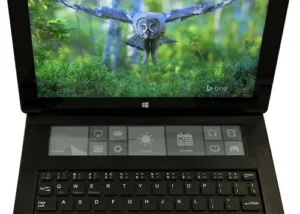Microsoft’s Applied Sciences Group (ASG) has been working with input devices for decades. There is a trend today towards miniaturisation, especially when it comes to portable devices. However, says the ASG, little research has been done into input methods on these products.
In 2009, the ASG showed off the Microsoft Adaptive Keyboard: a standard keyboard with a large, touch-sensitive display across the top. That work has been extended with the introduction of ‘DisplayCover’.
DisplayCover is a peripheral for touch-enabled laptops and convertible devices. It combines a tactile keyboard with a thin-film E Ink display, across the top – much like the old Adaptive Keyboard. The E Ink screen, with 1280 x 305 resolution, extends screen real estate. By using E Ink, impact on battery life is minimal.
The extra screen can be used in much the same way as the curved display on Samsung’s Galaxy S6 Edge, showing context-sensitive buttons. For example, it could show live tile buttons from the Start menu, or show toolbar links in an Office application.
Watch a video at http://tinyurl.com/owon5u7.
Analyst Comment
Touch makes this kind of extra display more useful than simple displays. Over the years, from Apricot in the 1980s, which had a small LCD in the keyboard of its PCs, there have been a lot of attempts to put extra displays in the keyboard, but none has really taken off. The addition of touch, along with low power operation both help, but the key is always getting application developers to support the extra display. (BR)

